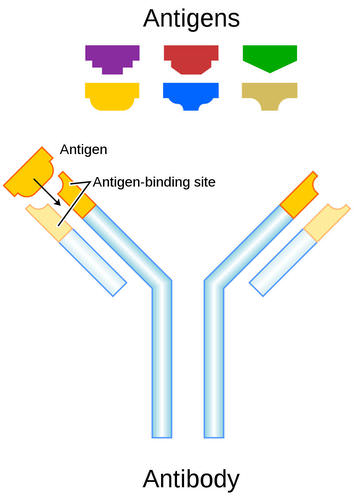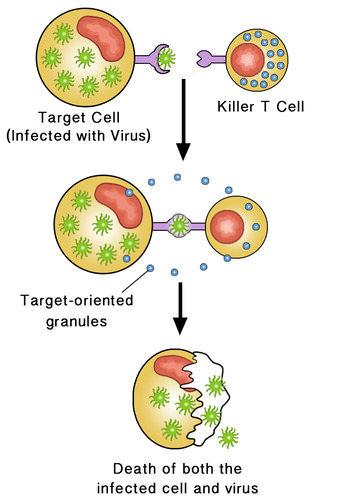11.62 应对不人道待遇
章节大纲
-
What happens when your body recognizes an invader?
::当你的身体承认入侵者时会怎样?When your immune system detects an invading , it goes on the attack! Notice how this T- cell is setting out to destroy a cell.
::当你的免疫系统探测到入侵时, 它会继续攻击! 注意这个T细胞是如何去摧毁一个细胞的 。B and T Cell Response
::B和T单元格反应Some defenses, like your skin and mucous membranes , are not designed to ward off a specific pathogen. They are just general defenders against disease. Your body also has defenses that are more specialized. Through the help of your immune system, your body can generate an army of cells to kill that one specific pathogen.
::有些防护,比如你的皮肤和粘膜膜, 并不是用来抵御某种病原体的。 它们只是一般的防病保护者。 你的身体也有更加专业化的防护。 通过免疫系统的帮助, 你的身体可以产生一组细胞来杀死一种特定的病原体。There are two different types of specific immune responses . One type involves B cells . The other type involves T cells . Recall that B cells and T cells are types of white blood cells that are key in the immune response . Whereas the immune system's first and second line of defense are more generalized or non-specific, the immune response is specific. It can be described as a specific response to a specific pathogen, meaning it uses methods to target just one pathogen at a time. These methods involve B and T cells.
::有两种不同类型的特定免疫反应。一种是B型细胞,另一种是T型细胞。请注意,B型和T型细胞是免疫反应的关键白细胞。虽然免疫系统的第一和第二条防御线比较普遍或不具体,但免疫反应是具体的。它可以被描述为对特定病原体的一种具体反应,意味着它使用的方法一次只针对一种病原体。这些方法涉及B型和T型细胞。B Cell Response
::B 单元格反应反应B cells respond to pathogens and other cells from outside the body in the and lymph . Most B cells fight infections by making antibodies . An antibody is a large, Y-shaped protein that binds to an antigen , a protein that is recognized as foreign. Antigens are found on the outside of bacteria , and other foreign microorganisms. Each antibody can bind with just one specific type of antigen ( Figure ). They fit together like a lock and key. Once an antigen and antibody bind together, they signal for a phagocyte to destroy them. Phagocytes are white blood cells that engulf targeted antigens by phagocytosis . As the antigen is on the outside of a pathogen, the pathogen is destroyed by this process.
::B细胞与病原体和淋巴体体外的病原体和其他细胞发生反应。大多数B细胞通过制造抗体来对抗感染。抗体是一种大型的、Y形的蛋白质,与一种被承认为外来的抗原 -- -- 一种蛋白质 -- -- 结合。抗原在细菌外体和其他外国微生物外体上发现。每种抗体只能与一种特定类型的抗原(Figure )结合。它们像锁和钥匙一样装配在一起。一旦抗原和抗体结合在一起,它们就会发出摧毁它们的信号。细胞细胞是白血细胞,通过发细胞将目标抗原吞没。由于抗原体在外体外,病原体会被这个过程摧毁。At any one time the average contains antibodies that can react with about 100,000,000 different antigens. This means that there can be 100,000,000 different antibody proteins in the body.
::任何一次平均都含有抗体,可以与大约10万种不同的抗原发生反应。这意味着体内可能存在10万种不同的抗体蛋白。This diagram shows how an antibody binds with an antigen. The antibody was produced by a B cell. It binds with just one type of antigen. Antibodies produced by different B cells bind with other types of antigens. The antigen-binding sites can vary, such that they are specific for just one antigen.
::这个图表显示了抗体与抗原的结合方式。 抗体是由 B 细胞生成的。 它只与一种抗原结合。 不同的B 细胞生成的抗体与其他种类的抗原结合。 抗原结合点可以不同, 只能针对一种抗原。T Cell Response
::T 单元格反应反应There are different types of T cells, including killer T cells and helper T cells . Killer T cells destroy infected, damaged, or cancerous body cells ( Figure ). When the killer T cell comes into contact with the infected cell, it releases poisons. The poisons make tiny holes in the of the infected cell. This causes the cell to burst open. Both the infected cell and the pathogens inside it are destroyed.
::有不同类型的T细胞,包括致命的T细胞和帮助T细胞。杀手T细胞摧毁被感染、损坏或癌症的身体细胞(图)。当杀手T细胞接触被感染的细胞时,就会释放毒药。毒药在被感染的细胞中造成小孔。这导致细胞破裂。被感染的细胞和体内的病原体都被摧毁。In this diagram, a killer T cell recognizes a body cell infected with a virus. After the killer T cell makes contact with the infected cell, it releases poisons that cause the infected cell to burst. This kills both the infected cell and the viruses inside it.
::在这张图中,杀手T型细胞识别感染病毒的体细胞。在杀手T型细胞接触被感染的细胞后,它释放出毒药,导致被感染的细胞爆发。这杀死了被感染的细胞和体内的病毒。Helper T cells do not destroy infected or damaged body cells. But they are still necessary for an immune response. They help by releasing chemicals that control other lymphocytes . The chemicals released by helper T cells “switch on” both B cells and killer T cells so they can recognize and fight specific pathogens.
::帮助T细胞不会摧毁被感染或损坏的身体细胞。 但是,它们仍然是免疫反应所必须的。 它们通过释放控制其他淋巴细胞的化学物质来提供帮助。 帮助T细胞释放的化学物质“对”B细胞和杀手T细胞“施压 ” , 以便识别和对抗特定的病原体。Summary
::摘要-
B cells produce antibodies against pathogens in the blood and lymph.
::B细胞产生抗体,抗血和淋巴中的病原体。 -
Killer T cells destroy body cells infected with pathogens.
::杀手T细胞摧毁感染病原体的身体细胞。
Review
::回顾-
Explain how B cells help fight infections.
::解释B细胞如何帮助防治感染。 -
Describe an antibody and its role.
::描述抗体及其作用。 -
How do killer T cells fight pathogens?
::T型杀手细胞如何对抗病原体? -
Describe the role of helper T cells.
::描述帮手T细胞的作用。
-
B cells produce antibodies against pathogens in the blood and lymph.


